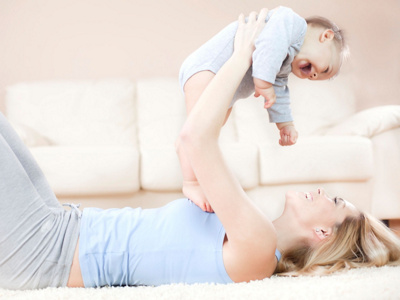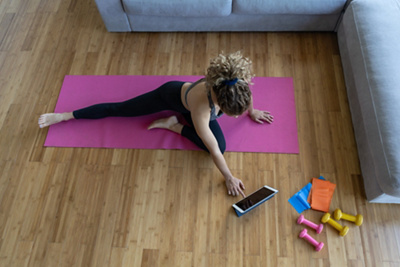Maternity gymnastics
Our physiotherapists can show you special exercises aimed at making your body feel fit again as soon as possible. Special back strengthening gymnastics aid in tautening your stomach muscles and strengthening your lower pelvis, and promote your feeling of physical and emotional wellbeing. Mothers are advised not to place unnecessary strain on their bodies in the first six to eight weeks following childbirth.

During pregnancy and childbirth, the pelvic floor and abdominal muscles are subject to considerable strain. Postnatal exercises are therefore essential in order to regain a healthy posture and to strengthen the muscles and tissue again. Our midwives show you which exercises will help you with your postnatal recovery.
How to correctly lie down, sit down and stand up
Protects the stomach muscles from excessive pressure
Sitting down on a chair
- Pull in your belly button and activate your pelvic floor.
- Assume a lunge position.
- Look back at the chair.
- Sit down with a straight back.
Standing up from a chair
- Pull in your belly button and activate your pelvic floor.
- Assume a lunge position.
- Bend forward while keeping your back straight.
- Push up strongly from the floor with your legs.
Lying down in bed
- Pull in your belly button.
- Slide onto your side.
- Lay down your head.
- Turn onto your back.
Getting up from the bed
- Pull in your belly button.
- Turn onto your side.
- With both arms push yourself up into a sitting position.
Lying down onto a mat
- Pull in your belly button.
- Assume a lunge position und come onto the mat with bend knees.
- Turn to the side and glide onto the mat with extended arms.
- Turn onto your back.
Standing up from a mat
- Pull in your belly button.
- Turn onto your side, leaving your head on the mat. Belly button stays pulled in.
- Push up with both arms.
- Assume the lunge position and stand up.
Abdominal Breathing
Activates the entire torso and helps you to relax
- Breathe in through your nose and let your stomach expand.
- Breathe out through your mouth and pull your stomach towards your spine.
- Repeat the exercise several times
Note:
- Activates the pelvic floor and supports the healing process.
- This exercise can either be performed on your hands and knees or lying on your back.
Pocket lamp
Mobilises the lower back and the pelvic floor
- Tilt your pelvis forwards while drawing your pubic bone towards your belly button.
- Tilt your pelvis backwards and increase the distance between your pubic bone and belly button.
- Complete the exercise slowly while keeping your breathing calm and steady.
Note:
- Helps with back pain around the sacral region (tailbone).
- This exercise can either be performed on your hands and knees or lying on your back.
One hand at a time
Strengthens the oblique abdominal muscles
- Get down on your hands and knees. Position your hands underneath your shoulders and your knees underneath your hips. Keep your back straight.
- Shift your weight from one hand to the other.
Note:
- To maintain a steady rhythm, you can say the words “tick-tock-tick-tock”.
Pelvic lift
Strengthens the back and the buttocks
- Pull in your belly button and activate your pelvic floor. Keep your back straight.
- Raise your pelvis and hold it for a moment. Slowly lower your pelvis back down to the floor.
- Repeat the exercise several times.



